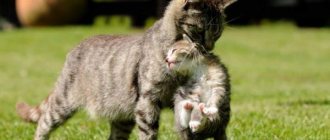My cat doesn't like to sit in my arms, what should I do?
One can only guess about the reasons for this behavior. Sometimes the reluctance to sit on hands is associated with the size of the cat or male cat, if they are too large. Then the animal simply does not fit on your lap and especially does not like to be hanging over you.
But most often the roots of this behavior lie in the field of psychology. Scottish cats are most often cats with character who do not like anyone to limit their freedom. And being picked up is the most extreme version of lack of freedom.
At first, the Scottish cat can still be patient, but most often it immediately begins to meow pitifully. If this does not help, claws and teeth, growling and even hissing begin to be used. Afterwards, the owner risks being left with bloody hands if he does not release the pet in time.
There is a version that the British, whose blood is in the Scottish family, were originally palace cats and were specially selected so that they did not like to sit on hands and served only as interior decoration. Plus, probably, their northern independent character is reflected in them, because the English aristocrats hardly liked to torment these cats with their hugs, as we do.
Beginning cat breeders who bring a Scot into their family have a desperate question: Do Scots even sit on their hands? Yes, they are sitting. On holidays. But if a Scottish cat suddenly wants to come to the owner, she will chatter to him, and lie on his lap, chest, or even head, and lick him, rewarding him with a light, affectionate kiss with her teeth (this is how tenderness is shown in cats).
What can you do to make your cat love to sit in your arms not only when she comes? You can't train her to do something she doesn't like. But you can use a little trickery and achieve the desired effect.
For example, many Scottish cats love to cuddle when they are asleep, so they can be stroked and picked up at this very moment. Others will happily sit in your arms if you stand next to the place that the cat is interested in, but which he cannot reach on his own.
Still others are happy and sit on their hands if they are allowed to rub their hair. However, most often the cat’s behavior will be as follows: the Scottish cat does not go into your arms, bites when you try to grab it, but willingly sits next to you, like a faithful dog. Such is the nature of this breed, nothing can be done.
However, if you are already picking her up, the cat also needs to be held correctly. The animal must have support on all four paws, this is the only way it feels confident.
Therefore, give him such support in the form of your hands so that the cat rests on you with each paw.
You can also recommend rewarding your pet with a treat after sitting in your arms. Then the owner's hug will cause a positive association.
Additionally, if you play aggressively with your cat using your bare hands, she may associate them with attack. It is not surprising that after this the cat will perceive your caresses as a threat. Therefore, sometimes you have to choose: either games or affection.
In general, the Scots are the kind of cat dogs who willingly follow their owner’s heels and are always present nearby. And if you don’t grab the cat in your arms every time he comes into view, the tailed cat will respond to you with complete trust. But it will only arise if you communicate as equals and do not use force.
You have taken home a living creature and you must understand that everything here is like with a person: you cannot influence his desires, including caressing you, since he is a separate person with his own opinion. Do you want to be loved? Then love yourself. And to love means to give freedom.
Scottish cats do not like hands, but they love to lie in hammocks. Try making a hammock from a long shawl or dress that will be attached to your neck, and place your pet there.
Perhaps he will enjoy it as much as the author's cat: then he will be able to lie in the hammock for an indefinite amount of time, and you will feel as if you have a pet in your arms.
Source: https://murkotiki.com/pochemu-shotlandskie-koshki-ne-sidyat-na-rukah
Character and temperament
There are cats that do not tolerate close contact at all, are unsociable and unsociable. They prefer solitude and do not seem to need human company at all. Some cats themselves do not take the initiative, but also do not run away when they are picked up; at the same time, they behave calmly, but at the first opportunity they sneak away unnoticed. Most often, a cat’s reluctance to sit in your arms is due to its character and temperamental characteristics. The harshest animals prefer complete solitude, and attempts to accustom them to handling will most likely end in failure.
A cat is a very sensitive creature; it can take offense at its owner. By refusing to sit in your arms, a cat can express its dissatisfaction in this way.
The domestic cat does not like to be petted
Why doesn't a cat like to sit in your arms, why doesn't a cat like to be petted?
- Both Persians and Britons don’t like to sit in their arms. They only allow themselves to be stroked when they have an episode of affection. They can sometimes rub against their legs and purr. If you pick them up, they just start to struggle, and when they’re in the mood, they look at the ceiling. They are not afraid of anything, they are as arrogant as tanks. They took both of them in as little ones for 1-2 months and taught them to be affectionate, but they don’t like this action. Apparently, they have too much personal space and they don’t approve of our interference in it).
- Well, it depends on what breed of cat. My cat really likes to lie on my lap when I sit. And she loves to be petted. If you have any stray wild cat, then she is simply not used to trusting people. Or maybe the cat just feels your anger or anger and is afraid.
- Cats are as different as people. There are some things they like and some things they hate. Everyone's characters are different. And breed plays an important role in this matter. They say that the British do not like to be touched, they immediately strive to bite or scratch. Perhaps this can be called willfulness. If a cat won't let you stroke its head, it doesn't mean it doesn't love you.
- My cat loved me so much that he followed me like a shadow. Where I go, he goes too. I’m in the kitchen and he’s with me, I’m in the garden and he’s following me, I’m in the living room and he’s following me, I’m sleeping and he’s following me, and he’s also slept only on me (try to drive him away - he’ll start biting). When she sees, she sits down on a chair and immediately sits on her knees. But when he sits on your lap, you can’t touch or stroke him, he’ll bite and run away. He didn’t recognize anyone except me and didn’t go to anyone. Wasn't wild at all. And now my cat always follows me everywhere, but he loves to be stroked and talked to, and to be looked at only at him at this time. Completely different character.
- Our cat has been living with us for 4 years, she simply idolizes her owner (my husband), but she won’t even sit in his arms. You can pet her only if she wants it herself. At the same time, he runs after us like a dog. It seems to me that all this is because cats are very independent. What the cat fell in love with as a child also plays an important role. For example, our Murka was afraid to eat when we first adopted her, and I stroked her to calm her down. Therefore, near the bowl you can pet it endlessly. And, of course, a lot depends on the character of the cat. They are all different, just like people.
Ways to train a kitten
Sometimes you can’t just calmly sit a kitten in your arms, because it gets scared and, even when it recognizes the person, continues to struggle. In order for a pet to be willingly given into the owner’s hands, it is necessary to accustom it to this, if it itself does not show a desire to actively make contact. As soon as the kitten realizes that communicating with the owner, when he takes him in his hands, brings him pleasure, the baby himself will strive to cuddle the person. Be sure to hold the kitten correctly, caress the pet and talk calmly to it. It’s very good if the cat starts playing while in your arms.
© shutterstock
Why not all pets like to sit on their owner's lap
Why do cats climb into their owners' arms? It turns out that in addition to the desire to refresh themselves, they may have many more reasons. In the owner's arms, the cat feels protected.
Cats have been living with people since ancient times, people take care of them and are touched by the behavior of their pets. To this day, these wayward animals have not fully opened up to their owners. Cats generally get used to the place, and not to the owner, and they show affection only when they want to achieve what they want.
Being in the arms of the owner can be a habit from birth. Cats can do this because they have been trained to be handled since childhood.
Little kittens, lying in the arms of their owners, move their paws; this happens on a reflex level, as if they were pressing their mother’s stomach when sucking milk.
Adult cats can climb into their owner's arms to feel protected in a dangerous situation, for example, when there are a lot of strangers in the house.
Often cats do this in order to play with their owner and win his goodwill.
Cats like to lie in the arms of calm people who sit quietly and are not dangerous. But there is one truth: as soon as the cat gets into your arms, urgent matters immediately appear that force you to get up and disturb the animal.
When a cat rubs its body against objects and door frames, it is marking its territory. She has glands on her body that secrete a special secretion with which the cat marks its territory. Since the cat considers its owner to be private property, it wants to leave its scent on him, that is, by climbing into his arms, she simply marks him.
The ancient belief that cats choose their owner’s sore spots and climb onto them, in this way relieving pain or even curing their owner, has now been confirmed by scientists.
Cats can sense negative energy, so they perfectly relieve fatigue and help calm the nervous system, which has a beneficial effect on overall well-being.
Therefore, everyone is recommended to have cats, pet them and relax.
Source: https://kotello.ru/pochemu-koshkam-nravitsya-sidet-u-hozyaina-na-rukah/
How to hand train a kitten
Teach your kitten to sit in your arms from childhood - from 4-6 weeks of age. Such early socialization will benefit the pet - it will be calmer and more trusting towards people.
How to accustom a cat to handling from “childhood”:
You need to lift the kitten correctly: supporting it with one palm under the stomach, the other under the butt, while the tail is gently pressed between the legs. Movements should be smooth and careful. It is better not to pick up a kitten by the scruff of the neck - only the mother cat determines a safe place with 100% probability.
Table 1. When and how to pick up a cat.
You can accustom an adult animal to contact with the help of unique exercises. To begin, simply slowly place your palm on the cat’s side and remove it just as slowly, then treat your pet with a treat. After a few days, place your other hand on the cat's other side, continuing to reinforce the training with treats. As soon as the cat gets used to it and is no longer afraid of the touch, begin to lightly press the sides with your palms, as if you were going to lift the pet. Repeat the exercise until the animal begins to perceive your touch as something familiar.
Features of cat behavior
Owners who keep cats at home have long noticed that cats love to climb onto your lap. It seemed like there was no cat nearby, not even in the room, but as soon as your favorite sofa creaked, the fluffy ball was right there.
The first thing that comes to mind is that I came to beg for a tidbit. After all, a loving owner, touched by such attention, will definitely give his pet something tasty. But this conclusion is not always true.
Man began to domesticate cats thousands of years ago. The ancient Egyptians were among the first to do this. Their relationship was based on mutually beneficial conditions. In ancient Egypt, agriculture was developed, grain was harvested and stored in barns. It is clear that there was no end to small (and large) rodents. That's when the cat came to the rescue.
The benefit is obvious - the harvest is saved, the cats are fed, and the owners are happy. Moreover, each exists independently of each other. This basis for the relationship between a cat and a person has been preserved to this day.
Cats are often capricious, with their own hidden character, and they get used to a place rather than a person, considering themselves the main ones in the house.
How not to behave around a cat
Cats are quite freedom-loving and touchy creatures. If the owner has ever offended the cat, the cat will never approach him again. And you can’t even dream of him jumping onto your lap. If the cat receives affection and attention from the owner, then gradually he will get used to the person and respond with mutual affection.
It should be remembered that cats will never do anything against their will. There is no need to forcefully hold them on your knees; this still will not lead to the desired result. The animal itself must want to sit or sleep on its owner’s lap.
If a small kitten tolerates the owner’s caresses normally, then at the first sign of anxiety, it should be released. When the animal begins to nervously beat its tail on the floor, it says that I’m tired, I have a lot of things to do.
Why Scottish cats are not attracted to their owners
It is difficult to immediately figure out what to do if the cat does not like to sit in your arms. It would seem that cats are affectionate animals and should be drawn to their owners, but this does not always happen. Why does the animal behave unusually, and how can it be raised?
Reasons why a cat doesn't like to be held
Pet lovers and breeders should remember that cats are by nature proud and self-sufficient animals.
Unlike dogs and other representatives of their kind, which are “social” and gather in packs or love their owner with all their hearts, cats usually live and walk on their own.
These are rather capricious animals, and they make friends with people solely for selfish motives.
But you shouldn’t be upset and disappointed in furry creatures; most of them eventually become attached to people and have warm feelings for them. Simply due to their nature, some of them could still have habits that their owners would not like.
The most capricious are cats and cats that were born or lived on the street for a long time. They can be called the most “wild”, since it is not easy for them to get used to life in an apartment and to people.
If you adopted a kitten or an adult cat from the street, be prepared for the fact that for some time it will avoid you and other inhabitants of the apartment.
However, it is not always street animals that cause problems. If a male cat is not separated from its mother in time, and the animal grows up in close relationships with its relatives, this can also negatively affect its future life with people.
Such cats begin to yearn for their mother and other representatives of their kind, so they are in no hurry to go into the arms of their owners.
Also, if the animal previously had other owners and they decided to resell it, cats may also be worried and not sit on their hands because of this.
Finally, any stress can turn any animal into a completely indifferent creature that avoids any contact and does not tolerate anyone trying to pick it up.
An animal may experience prolonged stress or depression if it is often offended or, on the contrary, ignored.
If for some time you have not pampered your cat with affection or even treated him cruelly, he is unlikely to sit calmly in the arms of such careless owners.
Closed and shy cats
A kitten that was not held or petted at an early age is unlikely to begin to experience a craving for sitting in a person's arms as it gets older.
In the best case, the animal can lie nearby, maintaining some distance. If a cat was born and raised on the street, then it is hardly surprising that human touches make her wary. An animal's negative life experiences cause it to experience fear, associating the proximity of human hands with unpleasant events and sensations. Only the sensitivity and patience of her owner will help her overcome this fear and learn to trust people again, at least her own.
Independent types of cats
The breed of a cat often speaks about how it relates to pets and people.
Breeds such as the British Shorthair and Scottish Fold are famous for their independent habits; they do not want to sit in a person’s arms or feel delighted at the sight of their breadwinner. In other words, they are not trying to curry favor with the “higher authorities,” but, on the contrary, they act from a position of strength and give the person the opportunity to only stroke himself. The above character can also be found in the inimitable Maine Coons. But not for everyone, since in life there are also friendly individuals who adapt to circumstances.
But mongrels easily make contact and rub against the owner’s legs, sit calmly in the arms and purr. True, among mongrel cats there are also aristocrats.











